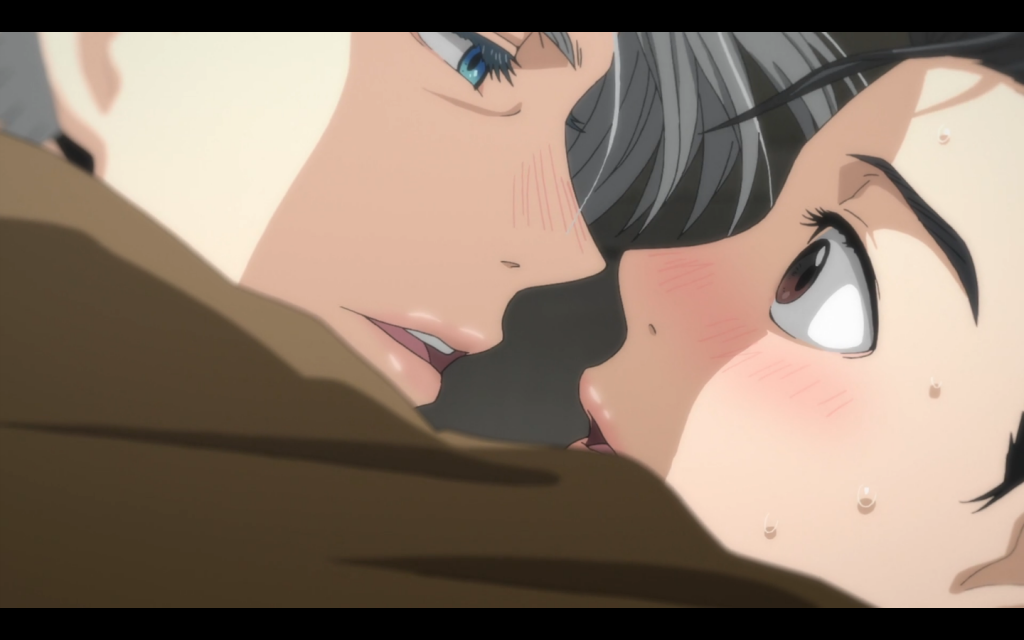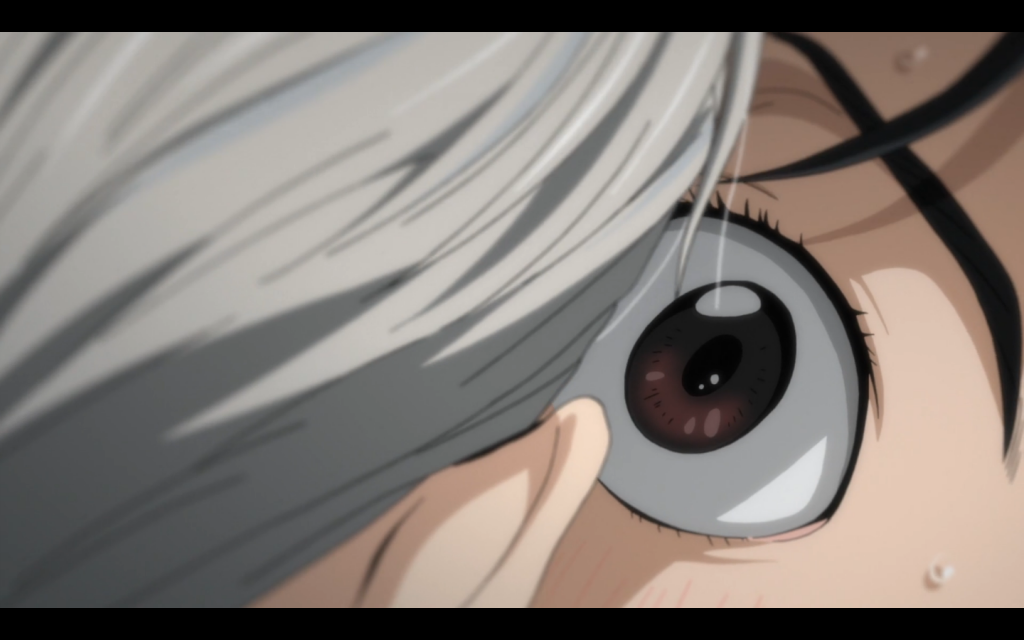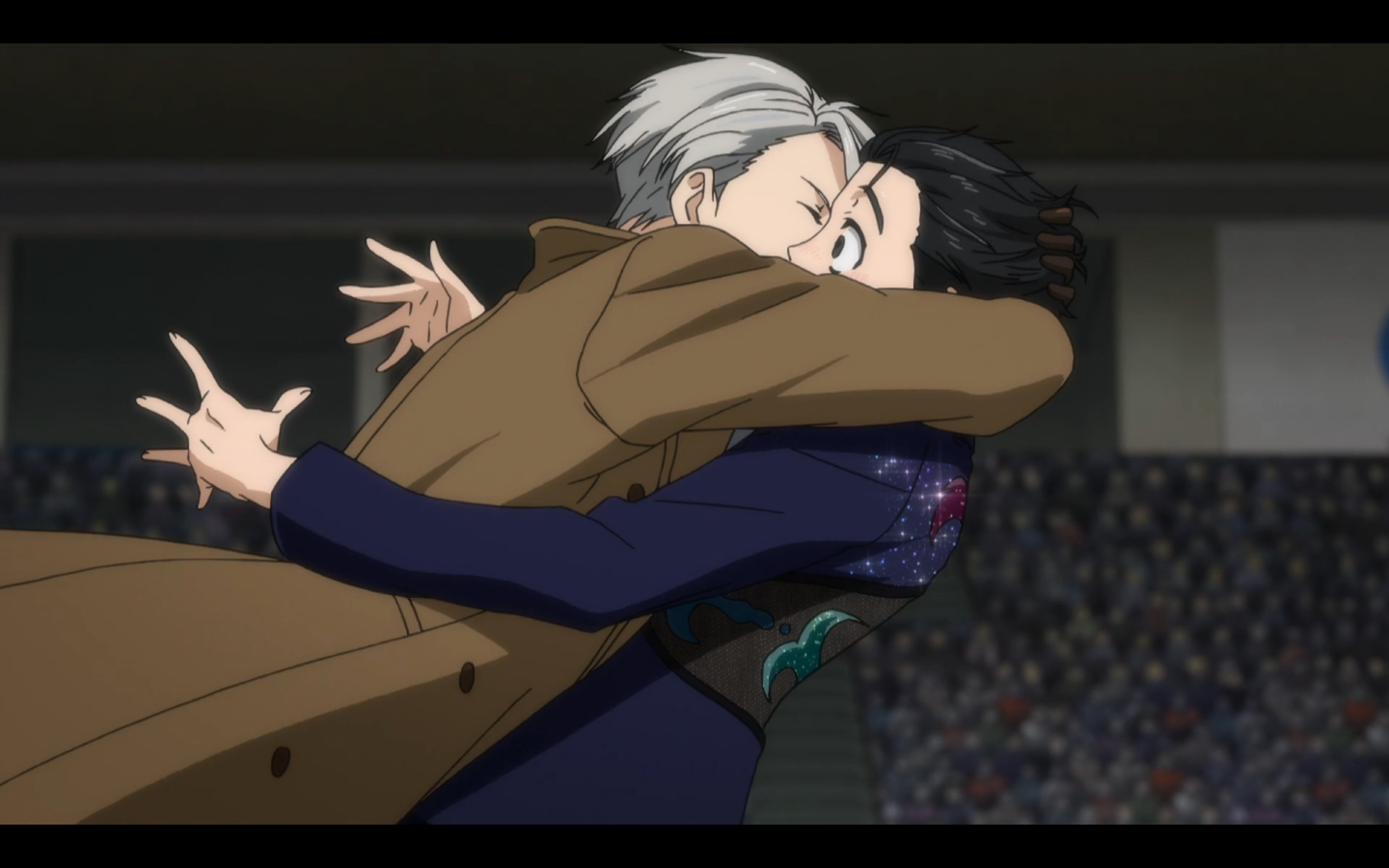Yuri!!! on Ice, undoubtedly the breakout hit of the Fall 2016 TV anime season, follows the dramatic comeback of figure skater Katsuki Yūri and his relationship with his hero and coach Victor Nikiforov. In English-speaking fandom, where political concerns about the representation of queerness on screen are more prevalent than in Japanese fandom, the show has been claimed as everything from simple “queerbaiting” to a historically remarkable instance of a gay romance in anime outside of the “boys love” romance genre.[1] The debate shifted when Yuri included a kiss between its two protagonists; this moment, combined with statements from the creators, led to a reassessment of the show by many English-speaking fans as explicitly about a queer romance. These interpretations, however, simplify Yuri’s position within a system of interaction between commercial anime/manga releases and fanworks in which, rather than the hierarchal opposition often seen between creator and fan in Western fandoms, both work in tandem to create spaces for reader imagination and creativity through the negotiation of queerness in subtext and text.
Though Yuri is a sports anime, it also belongs to the genre of anime aimed at adult women, female fans or fujoshi, which deliberately uses homoerotic subtext with the expectation that fans will be creating fanworks around them. Japanese fans’ love of m/m romance dates back to the 1970s with girls’ comics such as Heart of Thomas and Song of the Wind and Trees and is prominently seen today in the genre of commercial boys love or BL. Yet, it was the 1980s boys’ anime/manga series Captain Tsubasa, about a boys soccer team, which codified the appropriative, transformative type of fujoshi fandom we see today, in which women watch shows about male characters forming intense bonds and make their own “anime parody” fanworks, primarily art or comics (dōjinshi, amateur self-published zines). Unlike the mostly underground development of m/m-focused fandom in the U.S., the Japanese anime/manga industry quickly integrated fandom into its creative output and branding/merchandising, resulting in anime which explicitly court female fan creators and their interest in m/m romance. In current English-speaking fandom, this often reads as “queerbaiting”—the inclusion of queer subtext to exploit fan desire for queerness with no intention of following through with overt representation—but I would hesitate to apply this term to the Japanese industry and fandom, where queer relationships are understood to be overtly present, not in the text itself, but through the interaction between text and fan.
Recent anime series such as Yuri encourage fans’ queer desires with the understanding that those desires are better left partially unfulfilled—better for the studio’s bottom line (keep them wanting more) and better for the fans themselves, who have a thriving community based around fanworks which flourish through unfulfilled desires. This means narratives focus on intense male bonds and fan service (touches, suggestive lines), but it also means the gaps (particularly the moments when overt representation is just within reach but ultimately denied) are necessary for fans to fill in their own interpretation. In this system, while the series itself has significant authority as source material, it is not privileged hierarchically above the fanworks. Instead, the source material exists as something for fans to mine for situations, characters, and images, to rework into fan-created worlds which make queer relationships explicit according to their own imaginations. The obscuring of queerness in the source allows the development of multiple, varied, often conflicting queer interpretations in fanworks.
In this genre, therefore, queerness is both always centered and always off screen. Yuri’s kiss serves as illustration: it is depicted in such a way that the kiss itself is both never shown onscreen and completely undeniable. We see their faces in profile with each of their lips glimmering, eye-grabbing (Figure 1), then instead of seeing them touch, we see Victor’s face over Yuuri’s as his eyes widen (Figure 2).
In the profile shot where their lips would be touching, Victor’s arms cover the kiss itself (Figure 3), but reaction shots of the audience and Yuri’s loved ones (Figure 4) confirm that something quite shocking has happened.
This elision of the moment of contact replicates the relationship between text and fan in this genre: though the queerness itself is never visible, the fans nonetheless see it in their minds’ eyes, reflected here in the reactions of the audience seen on screen. The fact that it is a kiss, an undeniably romantic gesture which is never laughed off as a joke or explained away by Victor’s foreignness, is a step beyond the level of queer contact hinted in other similar anime. The avoidance of a lip-on-lip shot, therefore, serves to restore some of the ambiguity important to the genre while still pushing the limits of genre expectations towards explicit queerness. Never truly seen, the kiss happens without imposing a canonical interpretation of their relationship on the fan community which exists around the potential for a thousand kisses.
Caitlin Casiello is a Ph.D. student in the Combined Program in East Asian Languages and Literatures and Film and Media Studies at Yale University. Her current interests include Japanese pornography (live action, animated, pink, adult video) and queer filmmaking in Japan. Her master’s thesis, completed at Harvard University, focused on the legal controversies around and visual techniques of commercially-published pornographic Japanese comic books, but she secretly wanted it to be more about anime/manga fan communities and amateur creation of sexually-explicit material.
[1] See, e.g., “What’s So Gay About Yuri!!! on Ice?” by Jacob Chapman, Anime News Network, for a discussion of Yuri in the context of fan service and queer Western fan expectations: http://www.animenewsnetwork.com/feature/2016-11-02/what-so-gay-about-yuri-on-ice/.108391





Could you define the word queer as opposed to homosexuality? I think people conflate them when they are not the same thing. Also, queer is highly offensive in nature.
Queer is gay, in all its gayness. Queer folks reclaimed the word a while ago, sure some LGBTQ+ people may find it offensive and not want to use it, but many of us have taken it back and now it’s a term that many, many people are comfortable using.
I have always had issue with the term “queerbaiting”, doubting that actual gay folks would sit in front of a cheesy anime waiting for validation in a story line. Oh My! We Exist! 3 cheers for us! I always thought the obvious “baiting” was being done towards Slash fans and found the elision past “Slash” to “Queer” telling.
No weird straight women’s desires here: keep moving. Nope, it’s all for the gay folks but they are going to be disappointed again, by those shitty, mean producers… etc… Sound of wooden gears in the background being cranked….
Krist on Roller Skates! If YOI is doing m:m friendship and romance respectfully, that’s nice. However, any gay guys watching it do so fully aware that the story is not pitched primarily at them. They remain afterthoughts.
All this about a snog. Moueretsu Space Pirates did a full-on girl smooch in 2012 and then did it a second time seconds later just to prove that they meant it. (of course the gaze there was all us grubby neckbeard straight guy otaku, so I guess that don’t count?)
That said, without the gender studies folks, who have a well-developed conceptual toolkit to parse mediated desire and the motivation to grind at silly cartoons, our understanding of why these stories resonate with us would be stuck in the mists of prehistory. There is however, a totalizing tendency that captures some essayists because it makes life easier and feels like the inevitable march of progress, or at least a “win”.
I want to suggest that the understanding and the “win” could be bigger if more consideration was brought to bear on why all the straight boys and girls are following these stories and cheering from the cheap seats.
Your mileage as always, may differ.
Best of the season and thanks for this.
/M
Hi mudakun! Thanks for commenting! I agree about queerbaiting, which has a weird and twisted history as a fandom term—is it baiting fangirls with queerness? Is it baiting queers with queerness? Are fangirls all queer or mostly queer or are they just appropriating queerness? Seems to be how the debate always goes. I mostly think shows are “baiting” whoever they can get, but one way of maximizing viewership is, ironically, using genre patterns to target specific, solid audiences and, for better or worse, some of the genre patterns in anime rely on queer fan service of varying degrees.
I don’t think girl/girl subtext in a show aimed at male fans/otaku lacks the type of queerness I’m getting at above at all, where queerness undeniably exists, not as something explicit in the text but as something the fans are consuming, constructing, imagining based on deliberate subtext. (I mean, I’m a big Love Live fan so I’d be a hypocrite to dismiss male otaku shows with heavy lesbian subtext.) I do think male fan cultures and female fan cultures are different, both in US anime fandom and in Japanese fandom, and there are different social implications involved, but I think they have more in common than people often like to think. There are a lot of differences between GL fanworks/commercial yuri and BL fanworks/commercial works too, in terms of genre prevalence and consistency.
I don’t have an answer to your closing question, but it’s definitely something to think about for all of us. Best wishes to you too!
Yuri!!! on Ice, undoubtedly the breakout hit of the Fall 2016 TV anime season
I know it’s difficult, but, has anyone actually tried to run the numbers of Yuri!!! on Ice? And what will the DVD/merchandise sales be like? As a couple of people have mentioned, it’s entirely possible that a year from now, it’ll be as forgotten as something like Sakamichi no Apollon is now.
Hey Mikhail! I keep meaning to come and respond to these comments, but it’s a busy time of the year!
I just saw this article from ANN which has YOI as the top anime tweeted about for the fall season (via Kadokawa Ascii Research Laboratories trend analytics) with 1.4 million tweets (Haikyuu!! in second place has about 350,000): http://www.animenewsnetwork.com/interest/2016-12-21/yuri-on-ice-dominates-fall-anime-on-twitter-rankings/.110186 Obviously this would just be Japanese fans and has the usual problems with twitter data, but I think it’s a clear indication of popularity. The first BD/DVD just came out (today or yesterday, technically, but stores were selling it earlier this week) and I’m not sure there are sales numbers yet, but the soundtrack was no. 3 in physical and no. 1 in digital sales on Oricon in its first week. Even if the BD/DVD numbers don’t hold up, I think it’s pretty clearly the big hit of the fall—see Jacqueline’s comment above for the info on its CR popularity. In terms of other fan engagement, I see over 14,000 works in the general tag on Pixiv (so not including works which might only be in the fujoshi tag), 5784 works on AO3 (making it number 12 in anime/manga overall despite only airing this season), and Tumblr Fandometrics ranks it as the top new anime fandom in tumblr search for 2016 (fourth overall for the year.) Of course, I’m pretty biased in the parts of fandom I look at; maybe there are some other rubrics for numerical popularity people in other internet communities could check out.
None of this means it won’t be forgotten, but I don’t know if it will be like Sakamichi no Apollon. Which, echoing Jacqueline, is it really forgotten? I saw a talk partly about it like two weeks ago. They’re just very different shows ultimately so it seems odd you’d go to that one for a comparison. Yuri on Ice is already teasing a sequel series and filling up every store (and destroying everyone’s bank accounts) with merchandise; our eyes will surely be on it for a while.
That’s a good question. In terms of streaming on Crunchyroll, Re:Zero was actually more popular that Yuri!!! On Ice throughout the world. http://www.polygon.com/2016/12/29/14114196/top-anime-of-2016-crunchyroll
However, this data does include people who only, say, watch the first episode of a series, and Re:Zero started airing in April, while Yuri!!! started in September. When the Yuri!!! series finale aired, both Crunchyroll and tumblr crashed due to activity.
In Japan, the series finale prompted numerous twitter hashtags that went viral. I read that Yuri!! is the #1 selling DVD for women in Japan right now (of course, now I can’t find that ANN link :/)
With the teaser of another season, I think fans will be talking about this for a while.
Also, have people forgotten about Kids on the Slope? I love that show!
This was a really interesting read, and I’m glad you posted it. There’s definitely an undeniable difference in expectations that Western fans have in comparison to Japanese fans. The need to see explicit romantic scenes (e.g., mouth on mouth contact, etc.) has Western fans quick to criticize Japanese media of “queerbaiting” even when that criticism is unwarranted. Yuri!!! On Ice does manage to show more than other anime of the same genre is willing to, while still leaving things up to interpretation by fandom, yet that criticism is still there. It’s interesting to sit back and think about how fandom in different cultures operates. I also enjoyed seeing how you explored the cultivation of fandom and showed how the use of ambiguity within a narrative fuels it in this article.
Thanks for commenting, Kali! I appreciate your thoughts. I think a lot about how “explicit” a scene needs to be for the audience to believe that some sort of sexual contact has occurred; it’s something that’s very much culturally determined and historically determined—our standards for what suggested “sex” in Hollywood films, for example, are much different today (where you need to show something) than they were in the past (where you could only suggest and therefore suggestions became pregnant with meaning.) I haven’t done any overall research on this, but I think Japanese media is less fixated on the “kiss” as a sign of romantic completion; there’s a famous story of the American Occupation in the 50s encouraging Japanese movie studios to put kisses in their movies as a sign of democratic values, when before that Japanese films never had kisses. Obviously now there are plenty of kisses in Japanese media, but I think maybe it’s less deeply embedded as a symbol of “yes, now this relationship is real and valid” than it is in American media.
Thank you for writing this post; I thoroughly enjoyed it and the issues it brings to fore. The discussion of “queerbaiting” in Western English-speaking fandom is one that merits close attention. In the case of Yuri!!! on Ice, “queerbaiting” imposes queerness upon the series in a way that reflects Western fans’ ideals of what the purpose of the story is. This is coupled with Western fans’ assumptions about what the intentions of the creators of the series are. It reflects cultural differences in the consumption Japanese anime transnationally. Your article does an excellent and effective job of contextualising these issues.
Hi Rachel! Thanks for commenting. It’s always thorny to try to figure out these issues of cross-cultural consumption, so I’m glad this seemed to work for that. I’m always wary because obviously I am a Western fan (or I was before I became a Western aca-fan, which is possibly worse!) and I do think the meanings assigned to these shows by Western fans aren’t empty impositions; they are complicated moments of reception/interpretation in their own right and I’m dazzled by how divergent they can be. But your comment on queerbaiting is exactly what concerns me, that it’s an imposition of a Western queerness without taking into account the local context which offers its own frameworks for understanding these moments (and offers its own criticisms, since obviously there is a long history of criticisms of anime/manga from Japanese queer communities.)